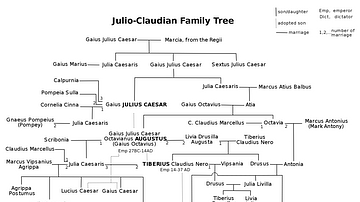Search
Remove Ads
Advertisement
Summary 
Loading AI-generated summary based on World History Encyclopedia articles ...
Search Results

Collection
Julio-Claudian Dynasty
The Julio-Claudian dynasty is the collective name given to the first five emperors of the ancient Roman Empire. The name of the dynasty derives from the names of the two families from which its members came: the Julii Caesares and Claudii...

Article
Rome under the Julio-Claudian Dynasty
The Julio-Claudians were the first dynasty to rule the Roman Empire. After the death of the dictator-for-life Julius Caesar in 44 BCE, his adopted son Octavian - later to become known as Augustus (r. 27 BCE - 14 CE) - fought a civil war against...

Image
Julio-Claudian Dynasty of the Roman Empire
A depiction of the evolution of the first imperial dynasty of ancient Rome, the Julio-Claudians that began with Augustus (Julius Caesar's adopted son) and included the reigns of Tiberius, Caligula, Claudius, and Nero. During their time, Rome...

Image
The Julio-Claudian Dynasty
The five Roman emperors of the Julio-Claudian dynasty. These were: Augustus (r. 27 BCE - 14 CE) - centre photo Tiberius (r. 14-37 CE) - top left Caligula (r. 37-41 CE) - top right Claudius (r. 41-54 CE) - bottom left Nero (r. 54-68...

Video
History of the Julio-Claudian Dynasty of the Roman Empire
The Julio-Claudian dynasty was the first dynasty to rule the Roman Empire. Octavian, the adopted son of the Dictator for life of the Roman Republic, Julius Caesar, became the first emperor of Rome after defeating Julius Caesar’s enemies after...

Video
Influential Imperial Women of the Julio-Claudian Dynasty
There were many famous women in Rome’s history from the early Kingdom of Rome through the Roman Republic but among the best known are those of the Roman Empire and, among these, the women of the Julio-Claudian Dynasty - the first dynasty...

Definition
Tang Dynasty
The Tang Dynasty (618-907 CE) was one of the greatest in Imperial Chinese history. It was a golden age of reform and cultural advancement which lay the foundation for policies which are still observed in China today. The second emperor, Taizong...

Definition
Shang Dynasty
The Shang Dynasty (c. 1600-1046 BCE) was the second dynasty of China, which succeeded the Xia Dynasty (c. 2070-1600 BCE) after the overthrow of the Xia tyrant Jie by the Shang leader, Tang. Since many historians question whether the Xia Dynasty...

Definition
Han Dynasty
The Han Dynasty (202 BCE - 220 CE) was the second dynasty of Imperial China (the era of centralized, dynastic government, 221 BCE - 1912 CE) which established the paradigm for all succeeding dynasties up through 1912 CE. It succeeded the...

Image
Julio-Claudian Family Tree
Family tree of Julio-Claudian Dynasty, which produced five emperors at the start of the Roman Empire (27 BCE - 68 CE).